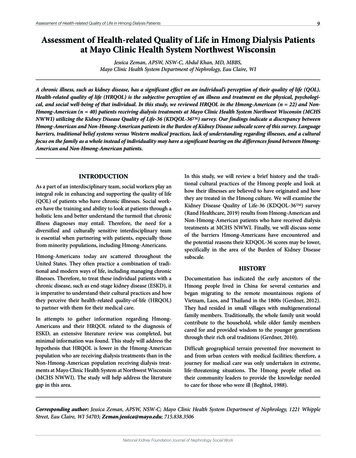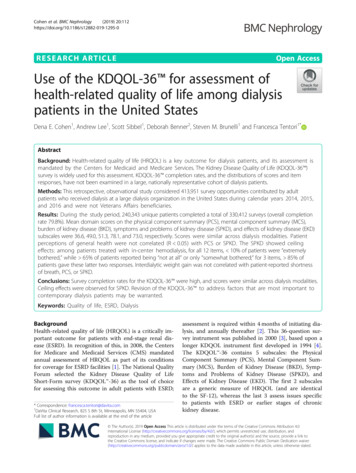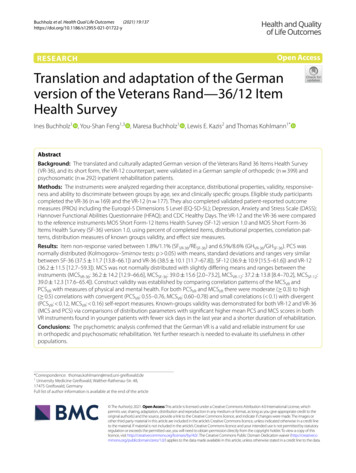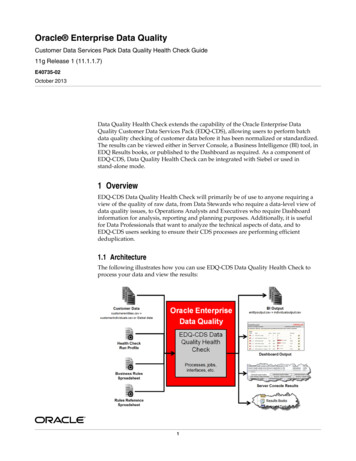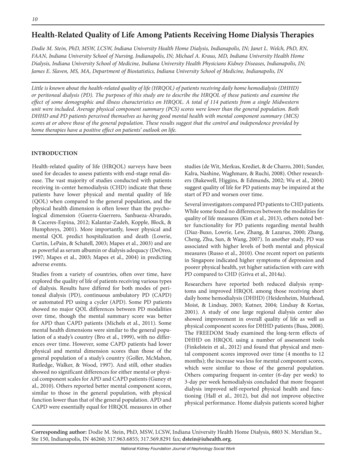
Transcription
10Health-Related Quality of Life Among Patients Receiving Home Dialysis TherapiesDodie M. Stein, PhD, MSW, LCSW, Indiana University Health Home Dialysis, Indianapolis, IN; Janet L. Welch, PhD, RN,FAAN, Indiana University School of Nursing, Indianapolis, IN; Michael A. Kraus, MD, Indiana University Health HomeDialysis, Indiana University School of Medicine, Indiana University Health Physicians Kidney Diseases, Indianapolis, IN;James E. Slaven, MS, MA, Department of Biostatistics, Indiana University School of Medicine, Indianapolis, INLittle is known about the health-related quality of life (HRQOL) of patients receiving daily home hemodialysis (DHHD)or peritoneal dialysis (PD). The purposes of this study are to describe the HRQOL of these patients and examine theeffect of some demographic and illness characteristics on HRQOL. A total of 114 patients from a single Midwesternunit were included. Average physical component summary (PCS) scores were lower than the general population. BothDHHD and PD patients perceived themselves as having good mental health with mental component summary (MCS)scores at or above those of the general population. These results suggest that the control and independence provided byhome therapies have a positive effect on patients’ outlook on life.INTRODUCTIONHealth-related quality of life (HRQOL) surveys have beenused for decades to assess patients with end-stage renal disease. The vast majority of studies conducted with patientsreceiving in-center hemodialysis (CHD) indicate that thesepatients have lower physical and mental quality of life(QOL) when compared to the general population, and thephysical health dimension is often lower than the psychological dimension (Guerra-Guerrero, Sanhueza-Alvarado,& Caceres-Espina, 2012; Kalantar-Zadeh, Kopple, Block, &Humphreys, 2001). More importantly, lower physical andmental QOL predict hospitalization and death (Lowrie,Curtin, LePain, & Schatell, 2003; Mapes et al., 2003) and areas powerful as serum albumin or dialysis adequacy (DeOreo,1997; Mapes et al., 2003; Mapes et al., 2004) in predictingadverse events.Studies from a variety of countries, often over time, haveexplored the quality of life of patients receiving various typesof dialysis. Results have differed for both modes of peritoneal dialysis (PD), continuous ambulatory PD (CAPD)or automated PD using a cycler (APD). Some PD patientsshowed no major QOL differences between PD modalitiesover time, though the mental summary score was betterfor APD than CAPD patients (Michels et al., 2011). Somemental health dimensions were similar to the general population of a study’s country (Bro et al., 1999), with no differences over time. However, some CAPD patients had lowerphysical and mental dimension scores than those of thegeneral population of a study’s country (Goller, McMahon,Rutledge, Walker, & Wood, 1997). And still, other studiesshowed no significant differences for either mental or physical component scales for APD and CAPD patients (Guney etal., 2010). Others reported better mental component scores,similar to those in the general population, with physicalfunction lower than that of the general population. APD andCAPD were essentially equal for HRQOL measures in otherstudies (de Wit, Merkus, Krediet, & de Charro, 2001; Sunder,Kalra, Nashine, Waghmare, & Ruchi, 2008). Other researchers (Bakewell, Higgins, & Edmunds, 2002; Wu et al., 2004)suggest quality of life for PD patients may be impaired at thestart of PD and worsen over time.Several investigators compared PD patients to CHD patients.While some found no differences between the modalities forquality of life measures (Kim et al., 2013), others noted better functionality for PD patients regarding mental health(Diaz-Buxo, Lowrie, Lew, Zhang, & Lazarus, 2000; Zhang,Cheng, Zhu, Sun, & Wang, 2007). In another study, PD wasassociated with higher levels of both mental and physicalmeasures (Russo et al., 2010). One recent report on patientsin Singapore indicated higher symptoms of depression andpoorer physical health, yet higher satisfaction with care withPD compared to CHD (Griva et al., 2014a).Researchers have reported both reduced dialysis symptoms and improved HRQOL among those receiving shortdaily home hemodialysis (DHHD) (Heidenheim, Muirhead,Moist, & Lindsay, 2003; Kutner, 2004; Lindsay & Kortas,2001). A study of one large regional dialysis center alsoshowed improvement in overall quality of life as well asphysical component scores for DHHD patients (Buss, 2008).The FREEDOM Study examined the long-term effects ofDHHD on HRQOL using a number of assessment tools(Finkelstein et al., 2012) and found that physical and mental component scores improved over time (4 months to 12months); the increase was less for mental component scores,which were similar to those of the general population.Others comparing frequent in-center (6-day per week) to3-day per week hemodialysis concluded that more frequentdialysis improved self-reported physical health and functioning (Hall et al., 2012), but did not improve objectivephysical performance. Home dialysis patients scored higherCorresponding author: Dodie M. Stein, PhD, MSW, LCSW, Indiana University Health Home Dialysis, 8803 N. Meridian St.,Ste 150, Indianapolis, IN 46260; 317.963.6855; 317.569.8291 fax; dstein@iuhealth.org.National Kidney Foundation Journal of Nephrology Social Work
11Home Dialysis HRQOLon the physical component of quality of life, comparedto CHD patients, though both scored equally well andsimilar to the general population on the mental component(Watanabe et al., 2014).A better understanding of the HRQOL of home dialysispatients would assist social workers and other professionalstaff in developing more effective interventions to helppatients improve their HRQOL. The purpose of this studywas to describe results on two subscales of the KDQOL -36:physical (PCS) and mental component scores (MCS), forboth DHHD and PD patients from one large home dialysisunit in the Midwestern United States. The PCS and MCSscores were each compared to demographic and illness/disease characteristics. Specific research questions were:1) What is the HRQOL for patients receiving home therapies (DHHD, PD) and is it different for the two treatments?2) Does HRQOL differ for individuals receiving DHHDor PD when differentiated by demographic characteristics(age, gender, and race)? 3) Does HRQOL differ for individuals receiving DHHD or PD when differentiated by disease/illness characteristics (diabetes status, length of timeon dialysis, access type, adequacy of dialysis (Kt/V), serumalbumin, and frequency of hospitalization)?METHODSDesign, Participants, and SettingPatients receiving DHHD, CAPD, or APD were includedin this retrospective descriptive study. Individuals wereineligible if they had dementia, active psychosis, or cognitive impairment; had not received care from the facilityfor less than three months; or were non-English speakers/readers for whom there was no native language translationor interpreter (Schatell & Witten, 2012). Patients also wereexcluded if they were receiving services from hospice, hadsevere physical disabilities that made them unable to independently complete most major activities of daily living, orhad a home hemodialysis thrice-weekly regimen.MeasuresQuality of life.The Kidney Disease Quality of Life survey (KDQOL-36)was used to measure quality of life. The KDQOL-36 is aderivation of the earlier KDQOL [dialysis version] (Hays,Kallich, Mapes, Coons, & Carter, 1994; RAND Corporation,2000), and consists of 36 items. In this study, the embedded12-item SF-12 (Ware, Kosinski, & Keller, 1995) was usedas a generic measure of HRQOL to produce both the nondisease-related PCS and MCS scores. The scores are basedon t-scores with a mean of 50 and standard deviation of 10for those in the general population. Higher PCS and MCSscores represent better HRQOL. Validity and reliability havebeen reported for both the original KDQOL (dialysis version) (Hays et al., 1994) and SF-12 (Lacson, Xu, Lin, Dean,Lazarus, & Hakim, 2010; Ware et al., 1995).Demographic and illness-related information.Demographic information included age, gender, and race.Illness-related variables included presence of diabetes,length of time on dialysis, type of access, Kt/V, serumalbumin, and frequency of hospitalization during the year.Data were retrieved from the medical record. Length oftime on dialysis was calculated from the date of a patient’sfirst training in the modality of use to the date of surveyadministration. Albumin levels for all patients were recorded on the month the survey was administered or withinthe month closest to that administration. For all but fourDHHD patients, Kt/V values were recorded nearest to or 1to 2 months prior of the survey administration date. For PDpatients, Kt/V values available closest to the survey’s mostrecent administration were recorded. However, the interimranged from 0 to 8 months, with some labs available onlyafter the survey’s administration and others not availableat all.ProceduresThe Institutional Review Board reviewed and accepted thestudy as meeting the criteria for exempt research. Over thecourse of the calendar year 2012, the KDQOL-36 survey wasfirst administered to new patients about three months afterstarting dialysis training. For most new patients, the surveywas completed after the patient had been home doing his/her own dialysis independently for at least a month. Forthose experienced and continuing home dialysis patients,the survey was administered annually. The scores used forthis study represent those obtained from the patient duringthe 2012 calendar year.Patients completed the survey by hand over 10 to 15 minutes, usually during a regularly scheduled monthly clinicvisit. For five patients whose native languages were notEnglish and/or whose reading or visual skills were poor,an interpreter, adult family member, or social worker readthe questions and answer choices to the patient in his/hernative language. Spanish was the primary language for twopatients, while Chinese was one patient’s only language.Responses to the survey were entered manually into anonline database, the Medical Education Institute’s KDQOLComplete subscription, to allow automatic scoring (MedicalEducation Institute, 2013). Data entry was double-checkedfor accuracy.Data AnalysisThe KDQOL-Complete analysis and report subscriptionprogram automatically calculates scores for each subscale.Data from the KDQOL-Complete were exported to anExcel spreadsheet. Data on number of months on dialysismodality, Kt/V, serum albumin, and number of hospitalizations during the year were added to the spreadsheet.National Kidney Foundation Journal of Nephrology Social Work
12National Kidney Foundation Journal of Nephrology Social Work, Volume 39, Issue 2Descriptive statistics were used for demographic and illnesscharacteristics of the sample. Data were analyzed by modality (DHHD and PD) and means, medians, and standarddeviations of each group were computed and compared. Fordifferences between modality type (DHHD vs. PD), ChiSquare tests were used for categorical variables and Student’st-tests for continuous variables. For associations of MCS andPCS scores with demographic and illness variables, analysisof variance models were used due to variables having morethan two categories. All analyses were unadjusted for covariates. All analytic assumptions were verified and all analyseswere performed using SAS v9.3 (SAS Institute, 2000-2012)RESULTSStudy Sample3) MCS scores were similar to those in the general, nondialysis population.Quality of Life ResultsMean SF-12 PCS and MCS scores in the general population have been reported as 50.12 and 50.04, respectively(Ware et al., 1995). Thus, both DHHD and PD patients inthis study perceived themselves as more debilitated physically than the general population. In contrast, in anotherstudy, patients receiving DHHD had improved physicaland mental-component summary scores over a 12-monthperiod (Finkelstein et al., 2012). In that study, 9% of patientsreceiving DHHD had a PCS score equivalent to the generalpopulation at baseline, increasing to 21% after 12 monthsof treatment, suggesting more longitudinal data are needed.The KDQOL-36 survey was completed, at least once, by atotal of 114 people receiving home dialysis. Fifty-two peoplewere on PD; 62% of these received CAPD. Sixty-two patientswere on daily home hemodialysis (DHHD), with 58 on shortdaily hemodialysis (SDHD) and 4 on extended or nocturnaldaily home dialysis (NHHD). Patients ranged in age from21 to 84 years of age with mean and median ages of 53.6 and54.5 years, respectively. As shown in Table 1, subjects werepredominantly male, equally divided by race, a third withdiabetes, and most (69%) on DHHD therapy had fistulas.Mean and median lengths of time on dialysis for all patientswere 31.3 and 27.3 months respectively, with a range of 2.5 to128.9 months. For DHHD, the mean and median were 37.9and 33.5 respectively with a range of 2.8 to 104.3 months.For PD, the mean and median were 23.4 and 15.8 respectively with a range of 2.5 to 128.9 months. Patients receivingDHHD were significantly more likely to be White (p .01),receiving dialysis for a longer period of time (p .03), notdiabetic, and with a higher serum albumin (p .01).Interventions that help patients change their perceptions oftheir physical capabilities and perceptions about their abilityto engage in physical activity and activities of daily livingwould be helpful. Enhancing physical health and encouraging physical activity (e.g., exercise programs) need to be promoted as well (Painter, 2009). Encouraging improved physical strength, stamina, and energy would be most importantfor general health, as well as getting back to work.FindingsPCS scores were lower in patients who were 40 years ofage and older. Other studies have shown that older ( 65)patients report better quality of life than younger patientson a HRQOL survey (Brown, 2015; Griva et al., 2014b),though APD results were better than those for CAPD on theKDQOL-SF (Griva et al., 2014b).Overall, mean PCS scores were 39.4 and mean MCS scoreswere 51.9. As shown in Table 2, there were no significant differences in the PCS or MCS scores by home dialysis modality. Because of this, scores were combined into an overallhome dialysis therapy score for the remaining analyses.As shown in Table 3, participants who were younger andnon-White had significantly higher PCS scores. There wereno significant differences in MCS scores with age, gender,or race. Participants who were diabetic and hospitalized atleast once had lower PCS scores. There were no significantdifferences in MCS scores with presence of diabetes, time ondialysis, dialysis adequacy, or serum albumin.DISCUSSIONThis study provided valuable information about the overallHRQOL of patients receiving home dialysis and the effectsof demographic and illness characteristics on their quality oflife. The main findings from this study were: 1) there wereno significant differences in PCS or MCS by home dialysismodality; 2) PCS scores were better in younger, non-White,non-diabetic patients who remained out of the hospital; andOn average, both DHHD and PD patients perceived themselves as having good mental health with scores at or abovethose reported decades ago for the general population (Wareet al., 1995). This finding is significant as previous QOLstudies have shown that dialysis patients, in general, havelower mental health scores when compared to healthy adults(Guerra-Guerrero et al., 2012). This suggests that the controland independence provided by home therapies may have apositive effect on patients’ outlook on life.Demographic Characteristics and HRQOLMore non-Whites had better PCS scores. This is consistentwith studies that show that Black hemodialysis patients havebetter HRQOL scores for the physical components withsevere comorbid conditions, though no differences wereobserved between races for mild to moderate co-morbidconditions (Unruh et al., 2004). It also is contrary to anotherstudy that showed Black PD patients with no higher perceived health status and quality of life than White patients(Kutner, Zhang, & Brogan, 2005). Black CHD patients havegreater survival than Whites (Feroze et al., 2011). The difference may reflect biologic “hardiness,” sociocultural differences, social and spiritual support, or even lower expectations or life experiences that ameliorate negative reactionsto dialysis (Kutner et al., 2005). In other words, the resultsin this study suggest that non-White patients may be moreresilient and self-sufficient.National Kidney Foundation Journal of Nephrology Social Work
13Home Dialysis HRQOLTable 1. Demographic and Illness Characteristics of the SampleNational Kidney Foundation Journal of Nephrology Social Work
14National Kidney Foundation Journal of Nephrology Social Work, Volume 39, Issue 2Table 2. Physical (PCS) and Mental (MCS) Component Summary Scores by Home Dialysis ModalityNational Kidney Foundation Journal of Nephrology Social Work
15Home Dialysis HRQOLTable 3. Physical (PCS) and Mental (MCS) Component Summary Scores by Demographic and Disease/Illness CharacteristicsNational Kidney Foundation Journal of Nephrology Social Work
16National Kidney Foundation Journal of Nephrology Social Work, Volume 39, Issue 2Illness Characteristics and HRQOLREFERENCESIt was not unexpected that patients who were diabetic hadlower PCS scores because diabetics often have neuropathy intheir hands and/or feet, and can be limited in their activities.In this study, PCS scores were also lower in patients withrepeated hospitalizations. The finding is consistent with previous findings suggesting lower PCS scores were predictiveof higher risks of hospitalization (Lacson et al., 2010).Bakewell, A. B., Higgins, R. M., & Edmunds, M. E. (2002).Quality of life in peritoneal dialysis patients: Declineover time and association with clinical outcomes.Kidney International, 61, 239–248.Bro, S., Bjorner, J. B., Tofte-Jensen, P., Klem, S., Almtoft, B.,Danielsen, H., et al. (1999). A prospective, randomizedmulticenter study comparing APD and CAPD treatment. Peritoneal Dialysis International, 19, 526–533.Brown, E. (2015). Peritoneal dialysis: Older patients reportbetter quality of life than younger. Evidence BasedNursing, 18(3). Published online January 20, 2015.doi:10.1136/eb-2014-101989Buss, M. L. (2008). Home hemodialysis and quality of life.Journal of Nephrology Social Work, 30, 14–17.DeOreo, P. B. (1997). Hemodialysis patient-assessed functional health status predicts continued survival, hospitalization, and dialysis-attendance compliance.American Journal of Kidney Diseases, 30, 204–212.de Wit, G. A., Merkus, M. P., Krediet, R. T., & de Charro,F. T. (2001). A comparison of quality of life of patientson automated and continuous ambulatory peritonealdialysis. Peritoneal Dialysis International, 21, 306–312.Diaz-Buxo, J., Lowrie, E., Lew, N., Zhang, H., & Lazarus,M. (2000). Quality-of-life evaluation using short form36: Comparison in hemodialysis and peritoneal dialysis patients. American Journal of Kidney Diseases, 35,293–300.Feroze, U., Noori, N., Kovesdy, C., Molnar, M., Martin, D.,Reina-Patton, A., et al. (2011). Quality-of-life and mortality in hemodialysis patients: Roles of race and nutritional status. Clinical Journal of the American Society ofNephrology, 6, 1100–1111. doi:10.2215/CJN.07690910Finkelstein, F. O., Schiller, B., Daoul, R., Gehr, T. W., Kraus,M. A., Lea, J., et al. (2012). At-home short daily hemodialysis improves the long-term health-related qualityof life. Kidney International, 82, 561–569.Goller, J. L., McMahon, J. M., Rutledge, C., Walker, R. G.,& Wood, S. E. (1997). Dialysis adequacy and selfreported health status in a group of CAPD patients[Abstract]. Advances in Peritoneal Dialysis, Conferenceon Peritoneal Dialysis, 13, 128–133.Griva, K., Kang, A. W., Yu, Z. L., Mooppil, N. K., Foo, M.,Chan, C. M., et al. (2014a). Quality of life and emotional distress between patients on peritoneal dialysis versus community-based hemodialysis [Abstract]. Qualityof Life Research, 23, 57–66.Griva, K., Yu, Z., Chan, S., Krisnasamy, T., Yamin, R. B.,Zakaria, F. B., et al. (2014b). Age is not a contraindication to home-based dialysis—Quality-of-life outcomesfavour older patients on peritoneal dialysis regimes relative to younger patients [Abstract]. Journal of AdvancedNursing, 70, 1902–1914. doi:10.1111/jan.12355.Guerra-Guerrero, V., Sanhueza-Alvarado, O., & CaceresEspina, M. (2012). Quality of life in people with chronic hemodialysis: Association with sociodemographic, medical-clinical and laboratory variables. RevistaLatino-Americana de Enfermagem, 20(5), 838–846.LIMITATIONS OF THE STUDY AND FUTURERESEARCHThis was a single unit retrospective study that assessed only2 of 5 subscales of the KDQOL-36 at one point in time. Thecharacteristics of the sample may limit generalizability ofthe findings because there were slightly more non-Whiteson PD and twice as many Whites on DHHD. In addition,patients on DHHD had been on dialysis longer than thosereceiving PD. These trends may reflect cultural or economicissues.Many demographic, disease, and psychosocial issues werenot explored: employment, financial status and stresses,etiology of kidney disease, mental health issues, familydynamics, role of the dialysis partner, kidney transplant history, or previous history of dialysis modality. Patients ondialysis, in general, may think of themselves as being “sick”and debilitated, although they engage in normal activitiesof daily living. Those not working and those receiving disability also may differ from those who continue to work inperceptions of their physical capabilities. It may be that thesedialysis patients perceive themselves as not having the physical stamina to work either full- or part-time.These additional demographic and psychosocial issueswould be useful to explore more explicitly in future studies.In addition, future research needs to look at the other subscale scores, scores over time, and the variety of psychosocialcharacteristics. Finally, there are some data that suggest thatanxiety, depression, and lack of ability to identify one’s ownemotions are important determinants of HRQOL (Varela,Vazquez, Bolanos, & Alonso, 2011) and may need to beexplored more fully in patients on home therapies.CONCLUSIONSAdministering the HRQOL survey is required of renal socialworkers. Given the differences in dialysis modalities, onemight expect HRQOL to differ. However, few data havebeen available on home therapies or how they compare. Theoverall goal of this study was to describe HRQOL for bothDHHD and PD and compare them on selected demographicand illness characteristics. While there were limitations tothe study, these results suggest that, for both modalities, control and independence as well as flexibility and autonomymay have a positive effect on patient outlook on life, despiteperceptions of being more debilitated physically. These findings suggest the need for more HRQOL research amongpeople receiving home therapies.National Kidney Foundation Journal of Nephrology Social Work
17Home Dialysis HRQOLGuney, I., Solak, Y., Atalay, H., Yazici, R., Altintepe, L., Kara,F., et al. (2010). Comparison of effects of automatedperitoneal dialysis and continuous ambulatory peritoneal dialysis on health-related quality of life, sleepquality, and depression. Hemodialysis International, 14,515–522. doi:10.1111/j.1542-4758.2010.00465.xHall, Y. N., Larive, B., Painter, P., Kaysen, G. A., Lindsay, R.M., Nissenson, A. R., et al. (2012). Effects of six versusthree times per week hemodialysis on physical performance, health, and functioning. Clinical Journal of theAmerican Society of Nephrology, 7, 707–710.Hays, R. D., Kallich, J. D., Mapes, D. L., Coons, S. J., &Carter, W. B. (1994). Development of the kidney disease quality of life (KDQOL) instrument. Quality of LifeResearch, 3, 329–338.Heidenheim, A. P., Muirhead, N., Moist, L., & Lindsay, R.M. (2003). Patient quality of life on quotidian hemodialysis. American Journal of Kidney Diseases, 42 (Suppl.,1), S36–S41.Kalantar-Zadeh, K., Kopple, J., Block, G., & Humphreys,M. (2001). Association among SF36 quality of lifemeasures and nutrition, hospitalization, and mortality in hemodialysis. Journal of the American Society ofNephrology, 12, 2797–2806.Kim, J., Kim, B., Park, K., Choi, J., Seo, J., Park, S., et al.(2013). Health-related quality of life with KDQOL-36and its association with self-efficacy and treatmentsatisfaction in Korean dialysis patients. Quality of LifeResearch, 22, 753–758. doi: 10.1007/s11136-012-0203-xKutner, N. (2004). Quality of life and daily dialysis. Seminarsin Dialysis, 17, 92–98.Kutner, N., Zhang, R., & Brogan, D. (2005). Race, gender, and incident dialysis patients’ reported healthstatus and quality of life. Journal of the AmericanSociety of Nephrology, 16, 1440–1448. doi:10.1681/ASN.2004080639Lacson, E., Xu, J., Lin, S. F., Dean, S. G., Lazarus, J. M., &Hakim, R. (2010). A comparison of SF-36 and SF-12composite scores and subsequent hospitalization andmortality risks in long-term dialysis patients. ClinicalJournal of the American Society of Nephrology, 5, 252–260. doi:10.2215/CJN.07231009Lindsay, R. M., & Kortas, C. (2001). Hemeral (daily) hemodialysis [Abstract]. Advances in Renal ReplacementTherapy, 8, 236–249.Lowrie, E. G., Curtin, R. B., LePain, N., & Schatell, D. (2003).Medical outcomes study short form-36: A consistentand powerful predictor of morbidity and mortality indialysis patients. American Journal of Kidney Diseases,41, 1286–1292. doi: 10.1016/S0272-6386(03)00361-5Mapes, D. L. Bragg-Gresham, J. L., Bommer, J., Fukuhara, S.,McKevitt, P., Wikstrom, B. et al. (2004). Health-relatedquality of life in the Dialysis Outcomes and PracticePatterns Study (DOPPS). American Journal of KidneyDiseases, 41, 1286–1292. doi:10.1053/j.ajkd.2004.08.012Mapes, D. L., Lopes, A. A., Satayathum, S., McCullough, K.P., Goodkin, D. A., Locatelli, F., et al. (2003). Healthrelated quality of life as a predictor of mortality andhospitalization: The Dialysis Outcomes and PracticePatterns Study (DOPPS). Kidney International, 64,339–349. doi:10.1046/j.1523-1755.2003.00072.xMedical Education Institute. (2013). Compliance madeeasy with KDQOL-Complete. Retrieved fromwww.KDQOL-Complete.org.Michels, W. M., van Dijk, S., Verduijn, M., Le Cessie, S.,Boeschoten, E. W., Dekker, F. W., et al. (2011). Qualityof life in automated and continuous ambulatory peritoneal dialysis. Peritoneal Dialysis International, 31,138–147. doi:10.3747/pdi.2010.00063Painter, P. (2009). Implementing exercise: What do weknow? Where do we go? Advances in Chronic KidneyDisease, 16, 536–544.RAND Corporation. (2000). Kidney Disease Quality of LifeInstrument (KDQOL). Retrieved from: www.rand.org/health/surveys tools/kdqol.html.Russo, G. E., Morgia, A., Cavallini, M., Centi, A., Broccoli,M., Cicchineli, A., et al. (2010). Quality of life assessment in patients on hemodialysis and peritoneal dialysis [Abstract]. Giornale Italianodi Nefrologia, 27, 290–295. PMID: 20540022SAS Institute (2000-2012). SAS 9.3 Help and Documentation.Cary, NC: SAS Institute.Schatell, D., & Witten, B. (2012). Measuring dialysis patients’health-related quality of life with the KDQOL-36TM.Retrieved December 9, 2012, from The MedicalEducation Institute website, www.kdqol-completeSunder, S., Kalra, O. P., Nashine, S., Waghmare, V., &Ruchi, R. (2008). Comparative study of adequacy ofdialysis and health-related quality of life in patients onCAPD and APD. Peritoneal Dialysis International, 28,542–544.Unruh, M., Miskulin, D., Yan, G., Hays, R., Benz, R., Kusek,J., et al. (2004). Racial differences in health-relatedquality of life among hemodialysis patients. KidneyInternational, 65, 1482–1491.Varela, L., Vazquez, M. I., Bolanos, L., & Alonso, R. (2011).Psychological predictors for health-related quality oflife in patients on peritoneal dialysis. Nefrologia, 31,97–106.Ware, J. E., Kosinski, M., & Keller, S. D. (1995). SF-12: Howto Score the SF-12 Physical and Mental Health SummaryScores (2nd ed.). Boston, MA: The Health Institute,New England Medical Center.Watanabe, Y., Yohno, T., Inoue, H., Takane, H., Okada,H., & Suzuki, H. (2014). Home hemodialysis andconventional in-center hemodialysis in Japan: A comparison of health-related quality of life. HemodialysisInternational, 18, S32–S38. doi:10.1111/hdi.12221National Kidney Foundation Journal of Nephrology Social Work
18National Kidney Foundation Journal of Nephrology Social Work, Volume 39, Issue 2Wu, A. W., Fink, N. E., Marsh-Manzi, J. V., Meyer, K. B.,Finkelstein, F. O., Chapman, M. M., et al. (2004).Changes in quality of life during hemodialysis andperitoneal dialysis treatment: Generic and disease specific measures. Journal of the American Society ofNephrology, 15, 743–753.Zhang, A. H., Cheng, L. T., Zhu, N., Sun, L. H., & Wang,T. (2007). Comparison of quality of life and causes ofhospitalization between hemodialysis and peritonealdialysis patients in China. Health and Quality of LifeOutcomes, 5, 49. doi: 10.1186/1477-7525-5–49.National Kidney Foundation Journal of Nephrology Social Work
The Kidney Disease Quality of Life survey (KDQOL-36) was used to measure quality of life. The KDQOL-36 is a . derivation of the earlier KDQOL [dialysis version] (Hays, Kallich, Mapes, Coons, & Carter, 1994; RAND Corporation, 2000), and consists of 36 items. In this study, the embedded 12-item SF-12 (Ware, Kosinski, & Keller, 1995) was used
